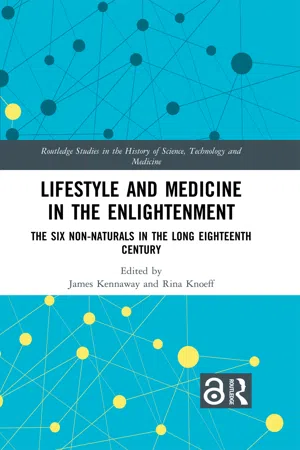
Lifestyle and Medicine in the Enlightenment
The Six Non-Naturals in the Long Eighteenth Century
- 320 pages
- English
- ePUB (mobile friendly)
- Available on iOS & Android
Lifestyle and Medicine in the Enlightenment
The Six Non-Naturals in the Long Eighteenth Century
About This Book
The biggest challenges in public health today are often related to attitudes, diet and exercise. In many ways, this marks a return to the state of medicine in the eighteenth century, when ideals of healthy living were a much more central part of the European consciousness than they have become since the advent of modern clinical medicine. Enlightenment advice on healthy lifestyle was often still discussed in terms of the six non-naturals – airs and places, food and drink, exercise, excretion and retention, and sleep and emotions. This volume examines what it meant to live healthily in the Enlightenment in the context of those non-naturals, showing both the profound continuities from Antiquity and the impact of newer conceptions of the body.
Chapter 8 of this book is freely available as a downloadable Open Access PDF under a Creative Commons Attribution-Non Commercial-No Derivatives 4.0 license available at http://www.taylorfrancis.com/books/e/9780429465642
Frequently asked questions
1 “The most valuable part of medicine”
Introduction

Courtesy of the Rijksmuseum Amsterdam.

Courtesy of the Rijksmuseum Amsterdam.

The six non-naturals
- 1. Airs, waters and places
The first non-natural is concerned with the effects of the environment on health and disease. It builds on the Hippocratic treatise Airs, Waters, Places, written around 400 bc, and is concerned with the quality of air, the health effects of the winds, the changing of the seasons, the quality of (drinking) water and the richness of the soil upon which people live. Interestingly, it is also about ways of life and social and cultural habits and includes descriptions of national stereotypes. - 2. Food and drink
During the Enlightenment, as worries about luxury lifestyles increased, healthy food and drink were a central concern in medical advice literature. Discussions not only focused on moderation and the question of what constitutes a moderate way of life but also included a constantly shifting debate about healthy and unhealthy food related to the variable factors of sex, age, employment, intelligence and lifestyle. - 3. Exercise and rest
Ever since the origin of the Greek gymnasium, doctors have given advice on the right amount of exercise for the body. In Antiquity, this advice focused on moderation: not too much, not too little, or, in the words of Galen, exercising with a small ball rather than running the marathon (Singer, 1997, pp. 299–304). The eighteenth century saw a revival of classical thinking on exercise, sports and health. These ideas were highly moral and embedded in philosophies of mind–body relations as well as rooted in burgeoning ideas about masculinity and the strength of the nation-state. - 4. Sleep and wakefulness
Although it is a relatively neglected area of research in premodern medicine, sleep and wakefulness were considered important indicators for health and well-being. Based on the Aristotelian treatise De somno et vigilia, physicians speculated about healthy sleep, dreaming, sleep terrors, insomnia, nocturnal emissions and sleepwalking. During the eighteenth century, sleep was closely related to discussions on social behaviour and morality, especially in the context of what Elizabeth Hunter in her chapter calls “the husbandry of time.” - 5. Excretion and retention (of faeces, urine, sweat, blood, semen, etc.)
Since the biological working of the body is involved, the labelling of excretion and retent...
Table of contents
- Cover
- Half-Title
- Series
- Title
- Copyright
- Contents
- List of illustrations
- List of contributors
- Acknowledgements
- 1 “The most valuable part of medicine”: The six non-naturals in the long eighteenth century
- PART 1 Airs, waters and places
- PART 2 Food and drink
- PART 3 Exercise and rest
- PART 4 Sleep and wakefulness
- PART 5 Excretion and retention
- PART 6 Passions and emotions
- EPILOGUE
- Index